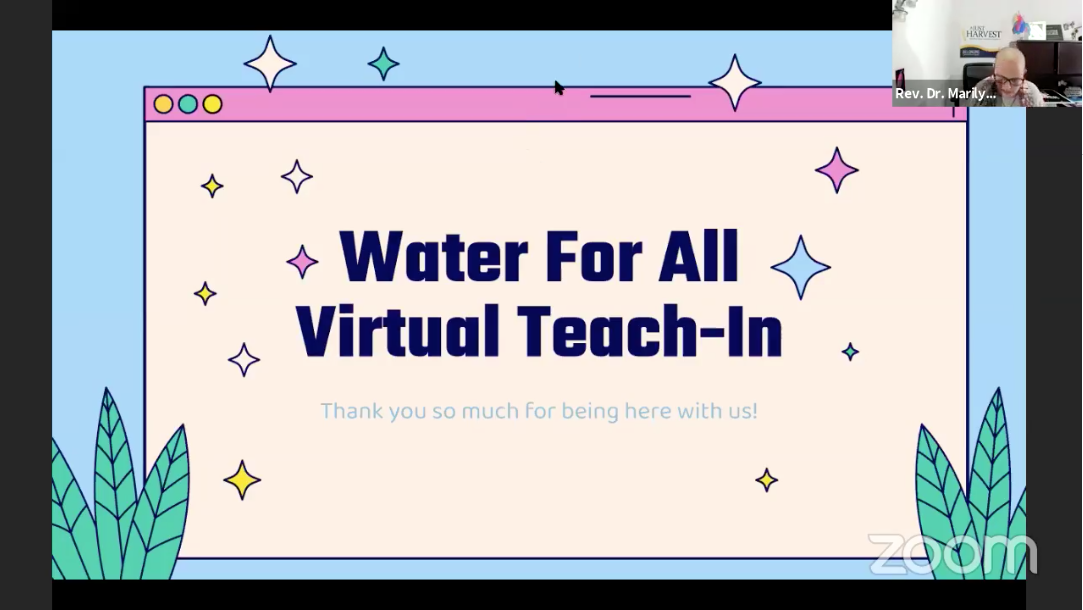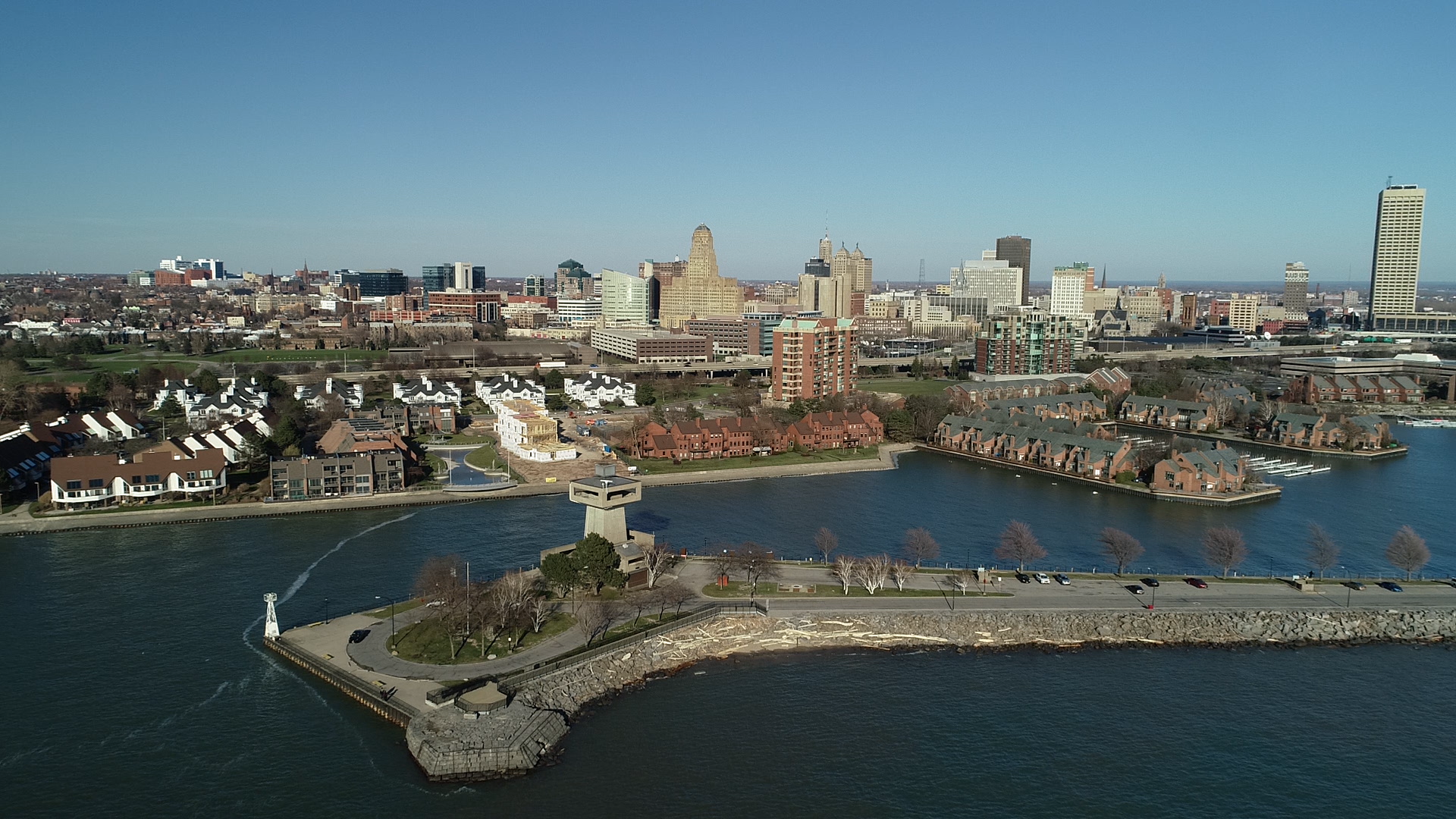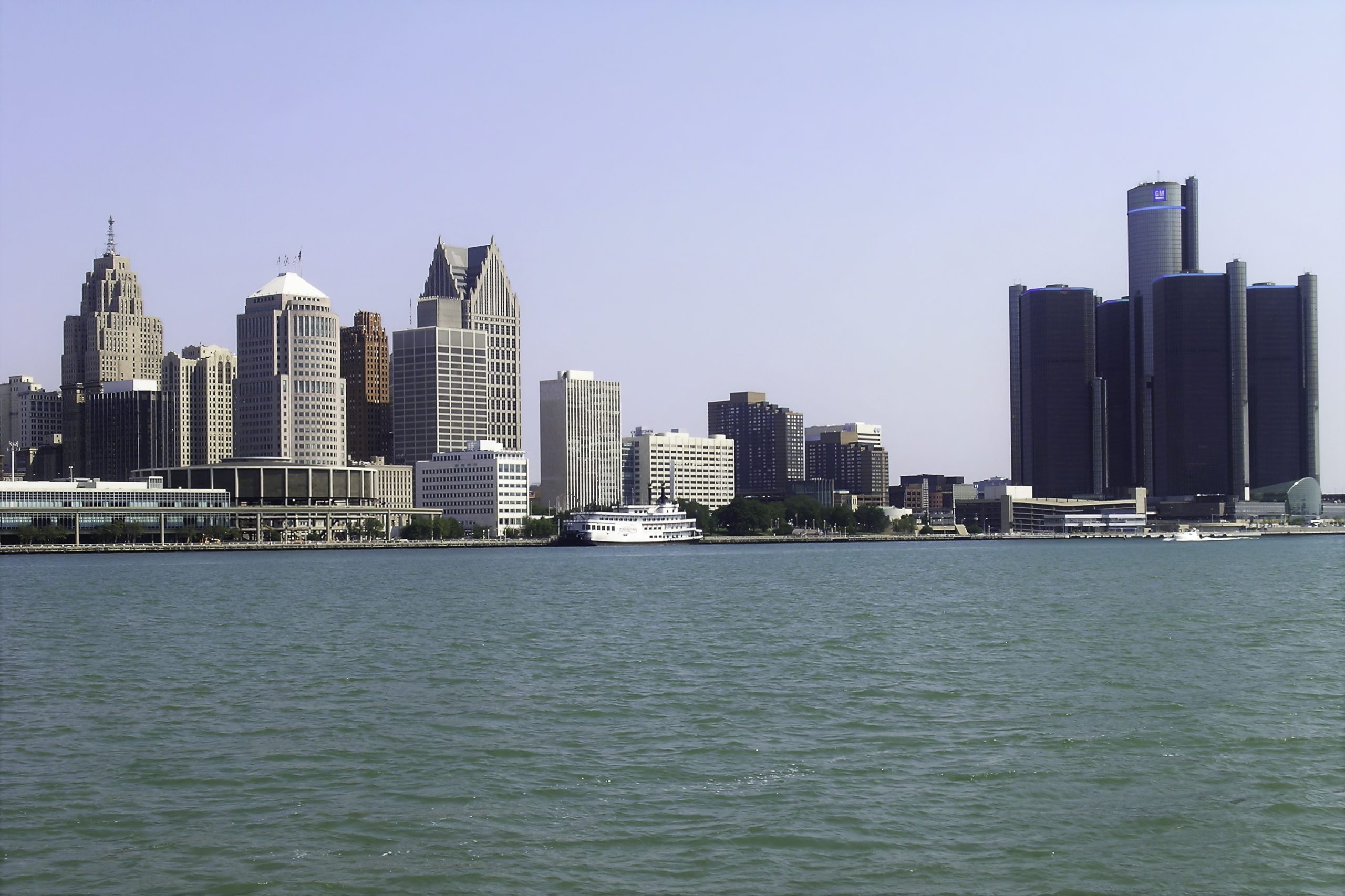
The Great Lakes News Collaborative includes Bridge Michigan; Circle of Blue; Great Lakes Now at Detroit Public Television; and Michigan Radio, Michigan’s NPR News Leader; who work together to bring audiences news and information about the impact of climate change, pollution, and aging infrastructure on the Great Lakes and drinking water. This independent journalism is supported by the Charles Stewart Mott Foundation. Find all the work HERE.
“Water is life, water is power, water is a right.”
So said Chicago Reverend Marilyn Pagan-Banks, to the sound of lapping waves on Lake Michigan, during a recent webinar promoting a proposed ordinance that would ensure drinking water access for all Chicagoans during the pandemic and beyond.
Even before the pandemic, Chicago had a moratorium on water shutoffs. Nonetheless, thousands of households are still without water, showing just how difficult ensuring water access can be. The situation also underscores the water security crisis that has long existed in many Great Lakes communities, which may get worse as shutoff moratoria imposed during the pandemic expire.
“As part of the Puerto Rican diaspora, for me water is life force,” Pagan-Banks continued. “I call her Lolita” — in reference to Lolita Lebrón — “one of the revolutionary warriors of the Puerto Rican independence movement.”

(Image courtesy of Food & Water Watch)
Following Pagan-Banks’ lead, other Black and Brown Chicagoans shared stories of their relationships with water, and the struggles of their families and communities to afford simple running water in their homes. They were advocating for the passage of an ordinance called Water for All, that would ban water shutoffs and tax foreclosures to collect household water bills; demand transparency and record-keeping on shutoffs; and otherwise relieve citizens of water debt.
Mayor Lori Lightfoot instituted the city’s water shutoff moratorium in 2019 after an investigation by public radio showed water rates had tripled over the last decade and about 150,000 households had received shut-off orders, concentrated in Black and Latinx communities.
Since then, shutoffs have ceased and some customers have been reconnected, but the city does not know exactly which or how many households are still without water, according to city council members and advocates. An investigation by WBEZ Chicago Public Media found that during the 10 months prior to the moratorium, the city issued shutoff notices to at least 2,700 households who as of January had not seen service restored.
“We empower our elected officials to manage our water in the name of the public trust,” said Rachel Havrelock, founder and director of the Freshwater Lab, a multidisciplinary initiative at the University of Illinois-Chicago, during the webinar.
Related news on Great Lakes Now:
Spotlight on Infrastructure: Policy executive talks new Biden plan, definitions of infrastructure
Speaking of Water: How Can the Biden Administration Deliver on Environmental Justice Pledges?
“Who in theory owns this water? When it comes from Lake Michigan and when it comes to Chicago, it is still public,” Havrelock continued. “We still have a public utility that is managing waters that we together hold in trust. We can go to our elected officials and say it is against the public trust if people are living without water in their homes. And it is against the public trust if we can’t get data in a pandemic about how many homes are going through this period of struggle without running water in their homes.”
Expired moratoria
Across the Great Lakes region, moratoria on water shutoffs that were instituted during the pandemic have expired, a number of them at the end of March, even as states including Michigan and Minnesota are seeing surges in coronavirus cases. New York is the only Great Lakes state with a statewide shutoff moratorium still in place, according to tracking by the national organization Food and Water Watch. On March 31, the day New York’s moratorium would have expired, the state legislature passed a bill extending it throughout the pandemic or until Dec. 31.
“There’s still a crisis and it’s only gotten worse,” said Mary Grant, Public Water for All campaign director for Food and Water Watch. “Less than half the country is protected under local and state moratoria.”
The organization is calling for a nationwide moratorium on water shutoffs, issued under the same authority that the Centers for Disease Control and Prevention used to institute a national moratorium on evictions during the pandemic. Democrats in Congress have pushed for such a moratorium, including through the proposed HEROES pandemic-relief package. Last fall, U.S. Rep. Rashida Tlaib (D-Detroit) co-authored a letter to the CDC pushing for a national water shutoff moratorium.
A recent study by Cornell University and Food and Water Watch found that states with moratoria on shutoffs had lower COVID-19 death and infection rates. The study surmised that more than 9,000 deaths and half a million infections could have been prevented with a nationwide moratorium on shutoffs.
During the pandemic 20 states imposed shut-off moratoria that applied to all water systems, and 14 states had moratoria that covered some utilities, according to Food and Water Watch.

Buffalo, New York (Photo Credit: Great Lakes Now)
Even with shutoff moratoria in place, only a small number of water utilities nationwide had programs for reconnection, according to Food and Water Watch. Grant said that some cities, like Miami and Philadelphia, were proactive and successful in reconnecting many households. In other cities including Detroit and Buffalo, residents needed to request reconnection.
“So people had to contact the utility; the onus was still on the household,” Grant said.
In the Great Lakes region, Wisconsin, Michigan, Ohio, Indiana and New York had comprehensive moratoria, while Illinois and Pennsylvania had partial moratoria and Minnesota had none. By December, all but the Michigan, Wisconsin and New York moratoria had expired.
Wisconsin’s moratorium ended on April 15, after the public service commission extended it from an earlier expiration date. Michigan’s moratorium ended on March 31, though Detroit has its own moratorium in place through 2022. In Michigan, a bill introduced by State Sen. Stephanie Chang would extend the moratorium, prohibiting water shutoffs for nonpayment of bills and mandating reconnection for shut-off households, along with imposing reporting requirements on water utilities.
In Detroit, policymakers took action after extensive organizing, data analysis and citizen research by community groups and activists like We the People of Detroit.
Detroit has not disconnected any water service for nonpayment during the pandemic and will “work on a long-term affordability plan with state and federal partners” while the moratorium is in place, according to city spokesman Bryan Peckinpaugh. He said that 1,300 households had service turned back on through the COVID-19 Water Restart Plan, “including emergency private plumbing repairs in order to get them clean water.”
Philadelphia announced it would extend its own moratorium on shutoffs through April 2022, and for several years the city has had a tiered billing program wherein lower-income people pay less for water

Detroit (Photo Credit: Lester Graham/Michigan Radio)
Dealing with debt
While moratoria have provided important relief during the pandemic, in most cases people will still owe outstanding water bills once a moratorium on shutoffs is lifted. That will be “crushing” for many, in Grant’s words, especially as countless Great Lakes residents will be affected economically by the pandemic for years to come.
A total of $1.1 billion in federal funds has been allocated for emergency water access and debt relief — the first time ever such an allocation has been made. The funding has not yet been distributed and the program’s structure is still being designed. Grant said those forthcoming funds will help cities forgive debt and develop more affordable water rates going forward. Additional rental and mortgage assistance programs included in federal pandemic-relief bills can also go toward utility payments, potentially including water.
Experts say still more federal, local and state funds and policy changes are needed to reconnect households who have been shut off and to create water billing structures that ensure water remains affordable and is viewed as a human right. Grant called on the federal government and cities to be guided by a United Nations decree that no one should pay more than 3% of their income for water.
In many cases utilities roll unpaid debt into their rate base, and then ratepayers are billed to cover those costs plus a guaranteed profit for the utilities. That means that in the case of water and electric and gas service, utilities could actually be profiting off the debt accrued during the pandemic or previously from unpaid bills, and forcing all ratepayers to pick up the tab.
“We’re really worried about them earning a profit off” the debt, Grant said. “We don’t think they should be profiting off families’ hardship. We think the cost (of unpaid bills) should be at least split, if not borne entirely by shareholders.”
In Chicago, a utility relief program allows low-income households to potentially have their water and sewer bills reduced by 50%. However, WBEZ found that the city had allocated about $9 million for the program, and households owe about $55 million in water debt.
In Pennsylvania, a state public utilities commission decision in March means that utilities must provide five-year payment plans and forgo any penalties for late payment for low-income customers. However, the commission allowed utilities to ultimately bill any unpaid debt to ratepayers and earn a rate of return (or profit) in the process.
In Wisconsin, the Public Service Commission asked energy and water utilities to file reports detailing how they will deal with the financial impact of unpaid bills. The commission noted in a memo that about 21,000 water customers had unpaid bills making them potentially subject to disconnection.
The Citizens Utility Board of Wisconsin noted in a comment filed with the commission that almost half of the state’s utilities had apparently failed to file the requested reports about arrears, and that the majority of the non-responders were likely water utilities.
“While all utility services are essential to modern life, none is more essential than water,” said CUB’s comment. “CUB finds it unconscionable that so many utilities will be allowed to disconnect residential customers beginning on April 15, despite their flagrant disregard for the Commission’s authority as evidenced by not even being able to muster a response to the Commission’s questions.”
CUB executive director Tom Content said that while they are disappointed the moratorium was lifted, the biggest priority now is helping people get on payment plans and access the federal and other funds that will soon become available to help pay water debt.
Since the state’s water is provided by government-owned utilities — unlike the investor-owned utilities that provide much of the state’s electricity and gas — shutoffs may be less likely, Content said.
As in many areas across the Great Lakes, Wisconsites’ unpaid water bills can be rolled into a household’s property tax bill. That creates higher tax payments and in extreme cases can lead to foreclosure or auction of homes. But in most cases, it means shutoffs are avoided and payment plans or debt forgiveness could ideally be worked out, Content said.
In Ontario and Quebec, there are not moratoriums, but water shutoffs have not been a major issue, according to Abhi Kantamneni, data insights manager with the organization CUSP (Canadian Urban Sustainability Practitioners). He said some utilities have revised rate plans to increase affordability, though on a larger level water access has been a major challenge for many First Nations communities and in some rural areas long before the pandemic.
Like U.S. advocates, he noted that families struggling to pay water bills are also likely struggling to pay energy bills, risking gas and electric shut-offs, foregoing other necessary spending and building up sometimes-insurmountable debt as a result.

High water bill in Detroit (Photo Credit: J Carl Ganter/Circle of Blue)
Infrastructure
Upgrading and overhauling water infrastructure can help with affordability, since leaking systems mean all ratepayers are paying for water lost in transit and inefficiency, and people with leaking pipes in their homes are paying for water they never even get.
The Chicago-based national organization Elevate has helped households who were disconnected because of major leaks and unpaid bills get reconnected, according to Elevate CEO Anne Evans. The organization has also worked with community groups like Blacks in Green to distribute bottled water to people in need. Evans would like to see cities implement programs like San Antonio’s Plumbers for the People, that provides emergency leak repair for low-income homes.
“Many people are probably not aware their neighbors in communities across the region are living without water,” Evans said. “It seems like, ‘How could that be when we live in such a water-rich region?’ There’s a need for raising awareness about water affordability more broadly and coming up with solutions.”
Last year Elevate, Chicago’s Metropolitan Planning Council and the Illinois Indiana Sea Grant released a study showing 75% of communities in Northeastern Illinois have seen water bills increase more than income has over the past decade.
The Biden administration’s massive infrastructure bill would include major investments in water infrastructure, as would the WATER Act, introduced by Sen. Bernie Sanders (D-VT) in the Senate and U.S. Rep. Brenda L. Lawrence (MI-14) in the House. The WATER Act would provide a water trust fund and almost $35 billion a year for infrastructure improvements and other aid related to accessible and clean drinking water access.
While infrastructure spending wouldn’t necessarily go directly to ensuring individual customers’ access to water, it is crucial to providing affordable and safe water for all Americans into the future, experts say.
“Localities facing aging infrastructure need it to be replaced,” said Grant. “By restoring that federal commitment to water on an ongoing and long-term basis, it will take the burden off local households. Water bills are a really regressive way to pay for infrastructure projects, a way that disproportionately burdens low-income households.”
“Any dollars that flow in to help utilities with any costs help all ratepayers down the road,” added Content, noting that many water providers have been “slow to keep up with” needed infrastructure improvements including lead pipe abatement.
Public spending on infrastructure and dealing with water debt are also crucial to preventing increased privatization of water services.
Water utilities that are saddled with debt in part because of the pandemic are especially vulnerable to takeovers by private companies, Grant noted. Privatization often means bills increase and transparency decreases, especially since such companies aren’t subject to open records laws. Chicago’s proposed Water for All ordinance would ban privatization.
In Chicago, A’Keisha Lee with the organization South Siders Organized for Unity and Liberation said many in her community still struggle to afford water or live without running water in their homes. During the webinar, she called on the city and the country to ensure no one ever has to go without water.
“While the pandemic and poverty are killing off communities, our city is denying the resource that is essential to life,” she said. “Water is needed to grow food, to prevent COVID and, more importantly, to live.”
Catch more news on Great Lakes Now:
Is the Line 5 tunnel a bridge to Michigan’s energy future or a bad deal?
Michigan Water Shutoffs: A test of governor’s commitment to social, environmental justice
Priority Shift: Great Lakes exec moves environmental justice to top of list
API key not valid. Please pass a valid API key.Featured image: Downtown Chicago (Photo Credit: J Carl Ganter/Circle of Blue)





